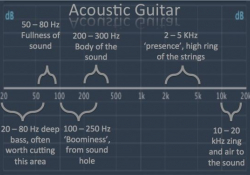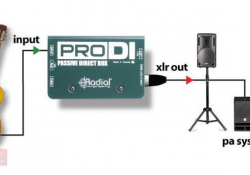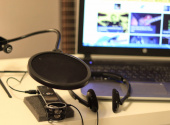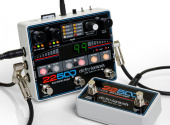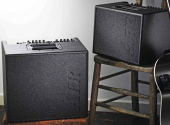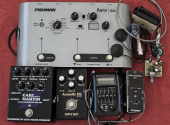
The Handbook for Electro Acoustic Guitarists, Chapter 6: Acupedia
Amplifying an acoustic guitar is a fairly complex discipline, however, there are just a few general principles that you need to follow – and thus avoid unnecessary problems on stage. Today, we'll cover a bit of "terminology", so that you don't feel like an idiot when communicating. Like I used to, for example, when a sound engineer explained to me how to tell mono and stereo cables apart.
Pickups, as you already know, convert mechanical vibrations into electrical signals (more on this in chapter 2). But since this is probably the most important part of the topic, let's briefly review the different types.
UST – under saddle transducer, also called piezo or bridge pickup
advantages – consistent, predictable sound relatively resistant to feedback, non-visible installation
disadvantages – piezo quack when played more vigorously
fits – different styles at medium to high volume
needs – guitar output socket, standard bridge, usually a preamp and battery
Magnetic pickup
advantages – most resistant to feedback, easy installation (does not have to be permanent), warm round sound
disadvantages – resembles electrical sound, blocks the soundhole, less sensitivity to the sound of the body
fits – deep round sounds, high volumes
needs – classic soundhole
SBT – soundboard transducer
advantages – the warm wooden sound of the guitar body
disadvantages – susceptible to feedback, can sound boxy, must be placed in a suitable place
fits – low volumes, percussive techniques
needs – a jack and an appropriate free spot (usually around the bottom of the bridge)
Internal microphone (actually a pickup in a way)
Advantages – the sound of strings and body, it doesn't get in the way
disadvantages – highly susceptible to feedback, needs equalisation to avoid hum<
fits – low volume, adds airiness to other types, percussive techniques
needs – phantom power, equaliser
External microphone
advantages – sound taken from the outside (similar to listening), without interference to the instrument<
disadvantages – highly susceptible to feedback, crosstalk on stage, needs to be close and not move too much
fits – very low volume small ensembles (duo, trio)
needs – phantom power
Combination of different types of amplification
advantages – best of different worlds, multi-dimensional sound
disadvantages – more difficult to install, more electronics in the instrument
fits – for more complex sound and more flexibility
needs – mixing multiple sound sources (blender, mixer)
Equalisation
Frequency modification of the sound, in simple terms, regulation of bass, midrange and treble. A human hears sounds from 20 Hz to 20 kHz, with an acoustic guitar typically in the 80 – 660 Hz range. Of course, this is only the fundamental tone, but the vibrating string resonates in multiples of the fundamental frequency. An acoustician would scold me for such a simplification, but again, there is no need to overcomplicate it and it is enough to remember a few things that can be set on different kinds of equalisers:
below 250 Hz: power, body, warmth, but if you overdo it, boomy
300-800 Hz: punch, but if you overdo it, muddy
1-3 kHz: presence, clarity, when it gets too high, harsh
above 5 kHz: sparkle, brilliance, when this band is missing the sound is dull
The terms, including equipment, get pretty intertwined, they interact and complement each other, so let's untangle them a bit...
Phantom power
Most commonly 48V for condenser microphones, where the required DC voltage is routed through an XLR cable.
XLR
A type of three-pin connector used for microphones and mixing consoles (also known as a cannon), it is mechanically more robust than a conventional jack and more suitable for transmitting signals over longer distances without interfering noise and hum. That's why when you need a cable from a sound engineer, he always has some "cannon" (unlike a guitar jack-jack cable, which is always better to have your own).
Jack
The most common type of guitar connector. Usually called mono jack (6.35 mm or ¼"). A stereo jack (TRS) can be recognised simply by the two rings. Stereo (also symmetrical or balanced) allows the transmission of two separate signals (suitable for combinations of pickups, for example).
DI box
It means direct input, a transducer of an unsymmetrical signal into a symmetrical one, for connecting instruments to a sound system (for non-specialists – a box that turns a jack into a cannon). It also usually handles impedance differences and is typically part of guitar preamps or multi-effects.
Impedance
A physical quantity about which the guitarist only needs to know that active pickups (battery-powered) have a high one (around 1 megaohm), preamps for acoustic guitars have high-impedance inputs (1-10 megaohms), while passive magnetic pickups, microphones or mixing consoles have a low impedance due to transmission losses in cables. It is therefore important when connecting a guitar and other audio equipment because if it were wired directly, the signal would be weak and thin with minimal bass. So the impedance of the output device must be equal to or higher than the source. This is why DI boxes are used as standard.
Notch filter
A specific kind of equaliser that cuts/turns down the feedback frequency.
IR or Impulse Response
A sophisticated method to enrich the sound with the "acoustic image" of the instrument, actually "adding" the microphone to the sound line... however, this simplification is beyond the pale. We will deal with this interesting and not very well-known topic next time.
If you have found an error or typo in the article, please let us know by e-mail info@insounder.org.

